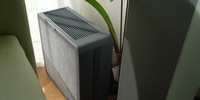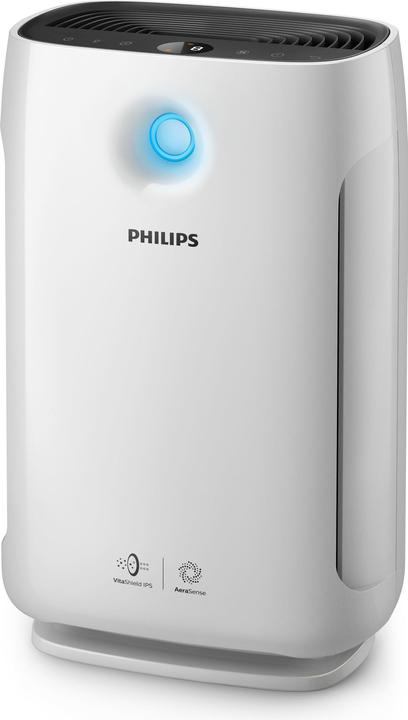

Stiftung Warentest under the magnifying glass: air purifiers
Air purifiers are designed to make life easier for allergy sufferers in particular. They filter pollen and other substances from the air. Stiftung Warentest has analysed how well they do this and we have added our findings.
Foundation Warentest is rightly an authority when it comes to product tests. We add further aspects to their results. The design, the manufacturer's reputation and the opinions of other testers are included in our overall result. A product test plus, so to speak.
And who comes out on top in this "Warentest Plus"? In short: Although the Beurer LR 500 performs significantly better in other tests than in the Stiftung Warentest, in the end it can only make up one place and is no match for the test winner from Philips.

The five best air purifiers in our range
We take a look at the five best air purifiers tested by Stiftung Warentest (issue 04/2020, subject to a charge) according to air purifiers that we have in our range.
The Stiftung Warentest awards the following (school) grades:
- Philips AC2889/10: 2.4
- Soehnle Airfresh Clean Connect 500: 2.5
- Rowenta Intense Pure Air Connect PU6080: 2.6
- De'Longhi AC 230: 3.7
- Beurer LR 500: 3.8
Reviews from other magazines
We found the five air purifiers in the best lists of four magazines. They landed in these places when Good Choice, testberichte.de, Haus & Garten Test and Guter Rat (not yet online) had only tested these five. The average ranking achieved by the individual air purifiers is interesting.
Best list rank per magazine
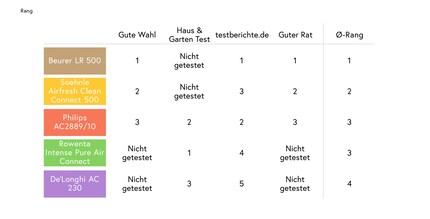
Strikingly, the Beurer LR 500 came first in the magazines, but received the worst rating from Stiftung Warentest. The Airfresh Clean Connect 500 from Soehnle came in second place and the Philips AC2889/10, which received the best rating from Stiftung Warentest, came in third place in the magazines.
The widely differing ratings of the Beurer LR 500 are due to different test procedures. In terms of operating noise and power consumption, it also came out on top in the Stiftung Warentest and was on a par with the test winner from Philips in terms of handling. It does not perform as well when it comes to measuring filtration: While the Beurer filters pollen as well as the competition, it is much less helpful against cigarette smoke and also does not filter formaldehyde, which can escape from paints and adhesives, at all. If a test now focuses on pollen and ignores cigarettes and formaldehyde or does not check the filter performance at all, the LR 500 is rated significantly better than by Stiftung Warentest.
Brand popularity
Hand on heart. Can you say with a clear conscience that the brand doesn't matter to you? Of course, new or less well-known manufacturers can also bring excellent products onto the market. But in the end, there is a bonus and a leap of faith in favour of the big and well-known brands.
Search interest on Google
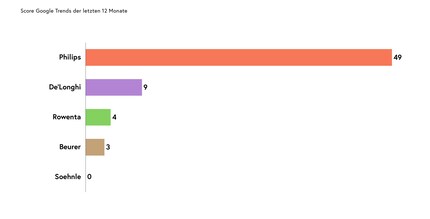
Our guide to the popularity and awareness of a brand is Google Trends. There, however, we do not look at general search queries, but at those in the shopping area.
A clear lead for Philips, which in recent decades has been successful with televisions, electric toothbrushes, epilators and a smart lighting system have become a well-known brand. Even De'Longhi, which is known for its coffee machines, can't keep up.
Design
The German consumer organisation Stiftung Warentest looked at filter performance and handling - factors that are at least half clearly measurable and assessable. We add the very subjective "design" factor. After all, an air purifier like this usually stands around in the living room. Which air purifier meets the taste of the masses just by looking at it? To find out, we conducted a - non-representative - survey in our Community.
Survey: Which air purifier is the most beautiful?
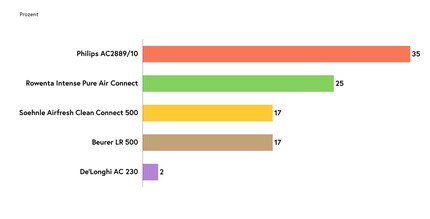
Optically, the De'Longhi AC 230 is not convincing. Almost nobody wants to have it in their living room. The other four, on the other hand, are comparatively close. Although the Philips AC2889/10 is still the clear winner in terms of design.
Conclusion: Philips maintains top position
At the end, we summarise all aspects: Stiftung Warentest's rating with the ratings of the other testers and the additional criteria of "brand popularity" and "design". But not equally. The two test areas of Stiftung Warentest and magazines each account for 35 per cent of the overall rating, with brand and design each accounting for 15 per cent.
Weighted overall rating across all criteria
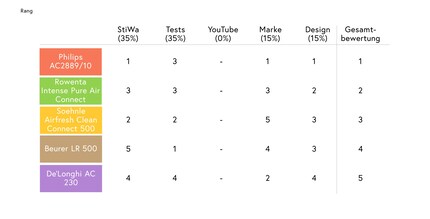
The name is damn unsexy, but the Philips AC2889/10 not only gets the best rating from Stiftung Warentest, it also comes out on top in our Warentest Plus test.
Room size and filter
But before you buy an air filter, there's one more thing you need to consider: Is the air purifier suitable for the size of your home? Manufacturers specify the number of square metres of living space their devices are designed for. In the case of the test winner Philips AC2889/10, for example, this is 79 square metres, while the Rowenta Intense Pure Air Connect is designed to cover 140 square metres. Most manufacturers therefore offer their air purifiers in different sizes. You need to make sure that they are sufficient for your needs. However, this is not easy, as it is actually about cleaning the air volume and this is higher per square metre in an old building or a new loft, for example, than in a standard rented flat with a lower ceiling height.
As the different evaluations of the Beurer LR 500 have shown, not every air purifier filters the same substances out of the air. They all actually collect pollen, but some models are unable to help with cigarette smoke or other vapours.
The air purifier filters cannot be used indefinitely. Although you can sometimes clean them yourself, you will need to replace them after a certain period of time. The cost of a new filter varies widely and can be up to 140 euros.
Air purifiers and viruses
Can air purifiers protect against infection with Covid19? Researchers at the Bundeswehr University in Munich have been looking into this question. They have investigated how the use of an air purifier affects the aerosol concentration in a room. In the 80 square metre test room - unknown total volume! - the proportion of aerosols halved in six minutes. However, the air purifiers require a hepa virus filter, otherwise the very small corona aerosols slip through - and most air purifiers for private use do not have this filter. They are primarily designed for larger pollen.
When I was but a young student, I'd sit in my friend's living room with all my classmates and play on his SuperNES. Since then I've had the opportunity to test out all the newest technology for you. I've done reviews at Curved, Computer Bild and Netzwelt, and have now arrived at Galaxus.de.
Practical solutions for everyday problems with technology, household hacks and much more.
Show all





